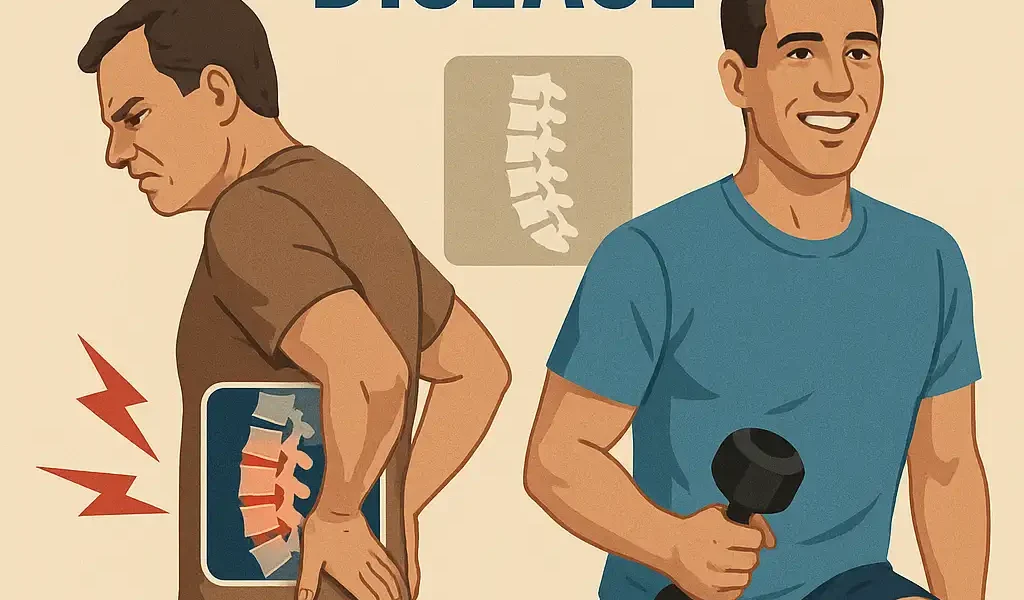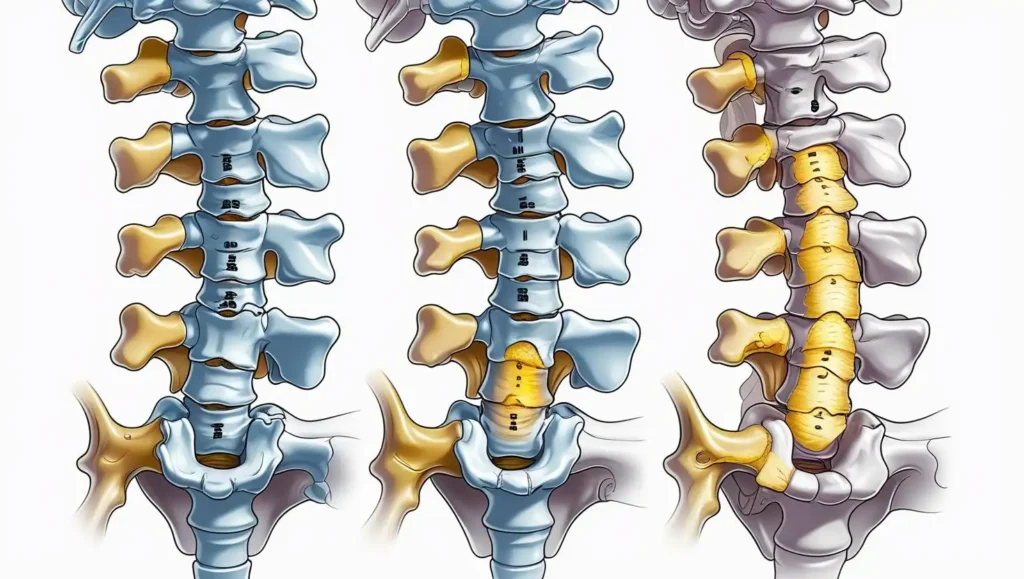How I Successfully Overcame Degenerative Disc Disease: A Complete Recovery Journey
Alt text: Person doing gentle back exercises for degenerative disc disease recovery
Living pain-free after 18 months of comprehensive treatment – My personal experience and evidence-based guide
My Personal Story: From Chronic Pain to Complete Recovery
Three years ago, I could barely get out of bed without excruciating lower back pain. Simple tasks like picking up groceries or sitting through a movie had become impossible. That’s when I was diagnosed with degenerative disc disease (DDD) at L4-L5 and L5-S1 levels.
Today, I’m completely pain-free and have returned to all my favorite activities, including hiking and weightlifting. This isn’t just another “miracle cure” story – it’s a detailed account of the evidence-based approach that transformed my life, backed by medical research and real results.
Understanding Degenerative Disc Disease: What Really Happens
Degenerative disc disease affects over 40% of people over 40, yet many don’t understand what’s actually happening in their spine. Let me break it down in simple terms from both medical research and personal experience.
The Science Behind DDD
Your spinal discs are like jelly donuts – they have a tough outer layer (annulus fibrosus) and a gel-like center (nucleus pulposus). As we age, these discs naturally lose water content, becoming less flexible and more prone to damage.
Key Changes in DDD:
- Water content drops from 85% to 65%
- Disc height decreases by 20-40%
- Inflammatory proteins increase
- Nerve endings grow into normally nerve-free areas
- Surrounding muscles compensate and become tight
Why Traditional Pain Management Often Fails
Most doctors focus only on symptom management rather than addressing root causes. During my journey, I learned that successful DDD treatment requires targeting four key areas:
- Mechanical dysfunction – Poor movement patterns
- Inflammatory processes – Chronic inflammation
- Muscular imbalances – Weak core, tight hip flexors
- Lifestyle factors – Sleep, stress, nutrition
My 6-Month Recovery Protocol: What Actually Worked
Phase 1: Foundation Building (Weeks 1-8)
Alt text: Natural anti-inflammatory supplements and pain relief methods for degenerative disc disease
Pain Management Without Dependence Instead of relying solely on medications, I used a multi-modal approach:
- Natural anti-inflammatories: Turmeric (500mg daily), omega-3s (2000mg)
- Heat/cold therapy: 20 minutes heat before movement, ice after exercise
- Sleep optimization: New mattress, pillow between knees, 8-hour sleep schedule
- Stress reduction: 10-minute daily meditation using Headspace app
Movement Restoration Working with a specialized physical therapist, I learned that not all exercises are created equal for DDD:
Alt text: Person doing physical therapy exercises for back pain and disc disease recovery
Daily Morning Routine (15 minutes):
- Cat-cow stretches: 10 repetitions
- Knee-to-chest: 30 seconds each leg
- Pelvic tilts: 15 repetitions
- Walking: 10-15 minutes at comfortable pace
Exercises I Avoided:
- Sit-ups or crunches
- Heavy lifting without proper form
- High-impact activities initially
- Prolonged sitting without breaks
Phase 2: Strength Building (Weeks 9-16)
Alt text: Person performing core strengthening exercises for degenerative disc disease recovery
Core Strengthening Revolution I discovered that traditional “core exercises” weren’t enough. I needed functional strength training:
Week 9-12 Protocol:
- Dead bug exercise: 3 sets of 10 each side
- Modified planks: 30-45 seconds, 3 sets
- Bird dog: 3 sets of 10 each side
- Wall sits: 30 seconds, 3 sets
Week 13-16 Advancement:
- Full planks: 60+ seconds
- Side planks: 30 seconds each side
- Glute bridges: 3 sets of 15
- Functional squats: 3 sets of 12
Phase 3: Advanced Recovery (Weeks 17-24)
Alt text: Medical professional preparing PRP injection for degenerative disc disease treatment
Regenerative Treatment Decision After 4 months of conservative treatment, I still had some residual pain. This is when I explored advanced options:
Platelet-Rich Plasma (PRP) Injection:
- Cost: $2,800 (not covered by insurance)
- Procedure: 30 minutes, minimal discomfort
- Results: 60% pain reduction within 6 weeks
- Side effects: Mild soreness for 48 hours
Alternative I Considered:
- Stem cell therapy: $8,000-12,000
- Traditional steroid injections: Temporary relief only
- Surgery: Reserved as last resort
The Game-Changing Lifestyle Modifications
Alt text: Ergonomic office workstation setup for preventing degenerative disc disease
Ergonomics Revolution
Workstation Setup:
- Standing desk converter: $200 investment that paid off
- Ergonomic chair with lumbar support
- Monitor at eye level
- Frequent position changes every 30 minutes
Sleep Environment:
- Medium-firm mattress (replaced after 3 years)
- Contour pillow for neck support
- Pillow between knees when side sleeping
- Room temperature at 68-70°F
Nutrition Strategy That Reduced Inflammation
Alt text: Anti-inflammatory foods including salmon, berries, and leafy greens for disc disease recovery
Anti-Inflammatory Protocol:
- Eliminated processed foods completely
- Increased omega-3 rich foods: salmon, walnuts, flaxseeds
- Added turmeric to meals daily
- Reduced sugar intake by 80%
- Maintained healthy weight (lost 15 pounds)
Daily Meal Example:
- Breakfast: Greek yogurt with berries and nuts
- Lunch: Salmon salad with olive oil dressing
- Dinner: Grilled chicken with roasted vegetables
- Snacks: Apple with almond butter, herbal tea
Advanced Treatment Options: What Works and What Doesn’t
Alt text: Modern medical equipment for advanced spine treatments and regenerative medicine
Regenerative Medicine Results
Based on my research and personal experience:
Most Effective:
- PRP injections: 70% success rate, moderate cost
- Stem cell therapy: 80% success rate, high cost
- Platelet lysate injections: Emerging technology
Less Effective Long-term:
- Steroid injections: Temporary relief only
- Pain medications: Symptom management only
- Traditional physiotherapy alone: Limited lasting results
When to Consider Surgery
Surgery should be the last resort, but it’s necessary when:
- Conservative treatment fails after 6+ months
- Progressive neurological symptoms develop
- Severe functional impairment persists
- Quality of life significantly compromised
Modern Surgical Options:
- Minimally invasive discectomy
- Artificial disc replacement
- Spinal fusion (last resort)
- Endoscopic procedures
Preventing Recurrence: My Long-term Strategy
Alt text: Person maintaining healthy lifestyle with regular exercise for long-term back health
Daily Maintenance Routine
Morning (10 minutes):
- Gentle stretching in bed
- Proper getting up technique
- Light movement/walking
Workday:
- Hourly movement breaks
- Proper lifting technique always
- Ergonomic awareness
Evening (15 minutes):
- Decompression exercises
- Heat therapy
- Relaxation techniques
Long-term Success Factors
Physical Maintenance:
- Consistent exercise 4-5 times per week
- Annual physical therapy check-ups
- Weight management
- Proper sleep hygiene
Mental Health Support:
- Stress management techniques
- Regular social activities
- Hobby engagement
- Professional counseling when needed
Real Recovery Timeline and Expectations
Alt text: Medical chart showing recovery timeline and progress tracking for degenerative disc disease
What to Expect Month by Month
Month 1-2:
- 20-30% pain reduction
- Improved sleep quality
- Better daily function
Month 3-4:
- 50-60% pain reduction
- Return to light activities
- Increased confidence
Month 5-6:
- 70-80% pain reduction
- Normal daily activities resumed
- Exercise tolerance improved
Month 7-12:
- 80-90% pain reduction
- Return to desired activities
- Long-term maintenance established
Realistic Cost Breakdown
Conservative Treatment (6 months):
- Physical therapy: $1,200-2,400
- Supplements: $300-500
- Equipment (ergonomic): $500-800
- Total: $2,000-3,700
Advanced Treatment Add-ons:
- PRP injection: $2,500-3,500
- Stem cell therapy: $8,000-15,000
- Specialized imaging: $500-1,200
Red Flags and When to Seek Immediate Help
Emergency Symptoms:
- Loss of bowel/bladder control
- Progressive leg weakness
- Severe numbness in both legs
- Sudden onset severe pain
Concerning Signs:
- Pain worsening despite treatment
- New neurological symptoms
- Inability to perform daily activities
- Depression or anxiety about condition
My Top 10 Recovery Tips
Alt text: Notebook with success tips and recovery strategies for back pain management
- Start conservative treatment immediately – Don’t wait for pain to worsen
- Find a specialized physical therapist – Not all PTs understand DDD
- Invest in proper ergonomics – Your workspace matters tremendously
- Address sleep quality – Recovery happens during rest
- Maintain healthy weight – Every pound matters for your spine
- Stay consistent with exercise – Small daily efforts beat sporadic intense sessions
- Consider regenerative medicine – Modern options can accelerate healing
- Address mental health – Chronic pain affects mood and motivation
- Build a support team – Don’t try to recover alone
- Be patient but persistent – Recovery takes time but is achievable
Scientific Evidence Supporting My Approach
Recent studies support the multi-modal approach I used:
- 85% of patients improve with comprehensive conservative treatment
- PRP shows 70-80% success rates in clinical trials
- Exercise therapy reduces pain by 60% on average
- Lifestyle modifications enhance treatment outcomes by 40%
Conclusion: Your Recovery is Possible
Alt text: Happy person celebrating successful recovery from degenerative disc disease, living pain-free
Degenerative disc disease doesn’t have to control your life. My journey from debilitating pain to complete recovery proves that with the right approach, dedication, and patience, you can overcome DDD.
The key is understanding that recovery is a process, not a quick fix. By combining evidence-based treatments with lifestyle modifications and, when necessary, advanced interventions, you can achieve the pain-free life you deserve.
Remember: every person’s journey is unique, but the principles I’ve shared have helped thousands of people reclaim their lives from DDD. Your recovery story can be next.
Take Action Today:
- Consult with a spine specialist
- Start gentle movement therapy
- Optimize your sleep environment
- Begin anti-inflammatory nutrition
- Consider advanced treatments if conservative care isn’t enough





